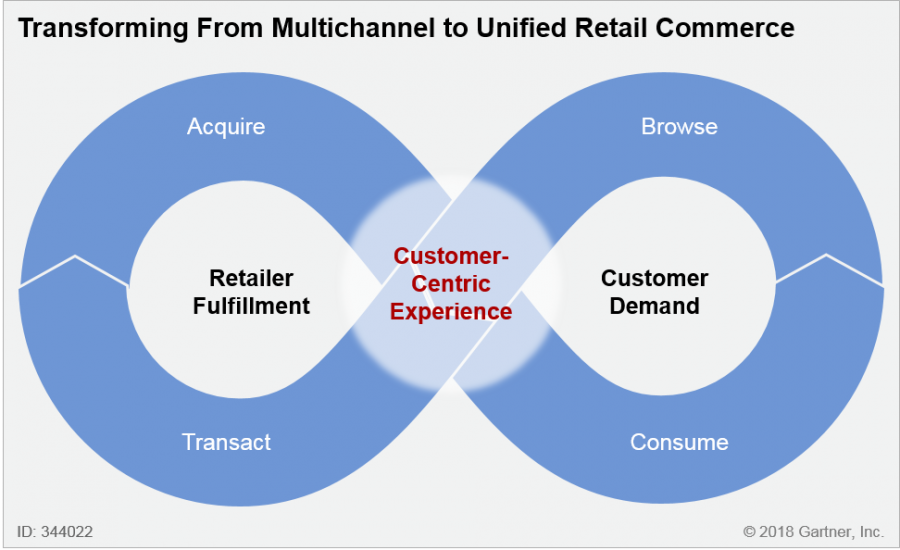March 21, 2023
Successful retailers are resilient, able to respond to changes in the market with agility and poise. In recent years, the role of technology has proven to be the biggest differentiator, enabling retailers to easily accommodate the unexpected, while less prepared entities simply fade away.
But with new technology and business models comes new methods in how we measure business and performance outcomes.
In a recent Gartner report, analysts examine this shift. The research emphasizes the role of strategic CIOs and other leaders in creating new, digital KPIs that measure and quantify progress, informing important decisions, and ensuring the success of the business.
Unified Retail Commerce
The experts at Gartner speak from the perspective of unified retail commerce (URC1), a modern business strategy that is reshaping the industry for all players including retailers and consumers.
Unlike multichannel retail, URC delivers a customer-centric experience based on how a consumer approaches shopping, with no limitation by channel. To achieve this result, retailers of all types must engage in digital business transformation that supports four customer processes:
- Browse and find what’s needed, discover new products and services, access via stores, online channels, mobile, social, IoT-enabled devices, AI, augmented reality, etc. for an immersive shopping experience.
- Transact within and across channels for products and services, without inconvenience or delays, using interconnected POS and mobile apps.
- Acquire goods and services using physical shopping, click and collect, in-home delivery, automated replenishment, and other methods, with flexible fulfillment models.
- Consume using enhanced information and services, connected devices, auto replenishment, and voice-enabled interactions.

URC works because it considers how consumers use technology day-to-day, then deploys its own technology that aligns with and supports this model, making lives simpler, better, easier, and safer.
New Retail KPIs for a New Business Model
Retailers have been focusing on customer-centricity for years. However, URC doubles down on the role of technology in delivering these outcomes, leveraging new innovations and edge solutions to deliver the very best customer experience.
As with any investment, retail CIOs and other leaders must be able to quantify how these new technologies are performing against URC and other business goals.
Traditional retail KPI methodology is no longer sufficient on its own, relying on lagging indicators measured as output. URC KPIs must also incorporate leading indicators that monitor and manage performance proactively in real-time, alerting the business to take measures before material losses occur.
Retailers must create digital KPIs that reflect the impact of the URC model on top level business performance. This requires connecting technology-outcome-driven metrics (TODM) to business-outcome-driven metrics (BODM).
For example, in order to identify net new revenue growth and business models, digital KPIs must measure platform revenue, connected revenue, and new industry revenue.
Three Core URC Pillars
The Gartner report identified three core pillars of URC strategy that drive profitability:
1. Unified Front and Back End
URC depends wholly upon a consolidated view of the retail experience, for the customer and for the business. Enterprise integration plays a critical role in this outcome, connecting independent components for a singular view of the operation, front and back.
This synchronized environment increases visibility, delivering consistently accurate and robust operational execution for an optimized customer experience.
A good example is Payless, an international, self-serve footwear retail chain, with almost 4,500 stores in 30 countries. The retailer implemented enterprise integration platform as a service (iPaaS) technology to roll out and integrate a new e-commerce platform within its existing infrastructure.
The new solution streamlines customer interactions, consolidating the data generated by retail data systems across multiple channels–even during surges in sales on Black Friday and other high-volume days.
2. Experience-led
URC promotes a digital workplace where it’s possible to track the experiences of customers and associates, and in turn the impact of new digital technologies on the business. With innovative toolsets and additional retail data, frontline workers and associates execute accurately, delivering personalized paths to purchase for better conversion and customer satisfaction.
With an enterprise iPaaS platform, retailers easily connect disparate systems so that data from a range of sources is consolidated and analyzed. For example, workforce planning, customer management, and retail data from other solutions help forecast employee scheduling with high and low traffic predictions for the very best customer (and employee) experience.
Digital retail KPIs within this example include the accuracy rate of auto-generated schedules, as well as the number of associates accessing mobile shift swapping and shift bidding. The insights generated help inform employee churn and attrition rates.
3. Composable
A truly unified retail commerce strategy is only possible with a composable business and technology strategy that connects applications, channels, and touchpoints in real time. Along with supporting digital transformation, this modular, API-first approach streamlines how retail data systems collect and analyze data.
The Gartner paper examines order substitutions at Walmart as an example of a composable architecture where the grocery chain implemented artificial intelligence capabilities within its existing environment. The technology is used to collect and combine retail data required to make intelligent substitution suggestions while tracking customer preferences.
As a result, the URC model is able to support real-time monitoring of item substitution acceptance rates, enabling better suggestions, reducing negative impacts, and increasing customer loyalty.
The digital retail KPI used in this example is the percentage of customers that accepted the suggested substitution.
The Role of Enterprise Integration in Unified Retail Commerce
Every retailer will weight digital KPIs differently, depending upon the nature of the business, types of customer groups, as well as immediate and longer-term objectives.
Regardless of these differentiators, a contemporary enterprise iPaaS is imperative in connecting all of the moving pieces, providing a singular view of the business that supports and informs the URC model.
Digibee works with organizations intent on evolving their business model. Our customers leverage Digibee’s low-code iPaaS to integrate modern systems with existing technologies, significantly reducing the time and resources needed to accelerate innovation.
Digibee iPaaS technology enables a resilient and agile data strategy that easily grows with your organization, regardless of size or scale. We help our customers evolve their business, leveraging Digibee’s low-code iPaaS to integrate modern systems with existing technologies, streamlining the flow of data across the operation for a singular view of the business.
If you’re interested in how Digibee can help your retail organization, we are happy to show you. Book your choice of a discovery call (15 minutes), custom demo (30 minutes) or a deep dive (60 minutes) to learn more.
(1) Gartner, Use Digital Business KPIs to Assess and Improve Unified Retail Commerce Performance, 1 December 2022, Hanna Karki, Kelsie Marian
GARTNER is a registered trademark and service mark of Gartner, Inc. and/or its affiliates in the U.S. and internationally and is used herein with permission. All rights reserved.








